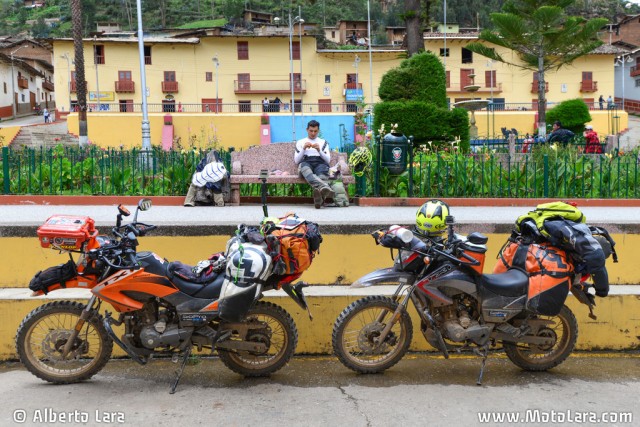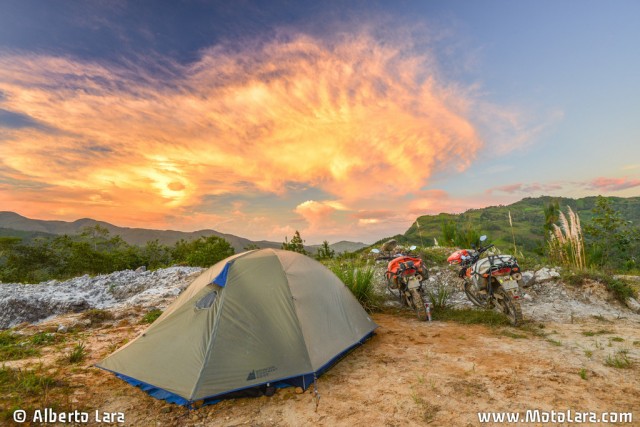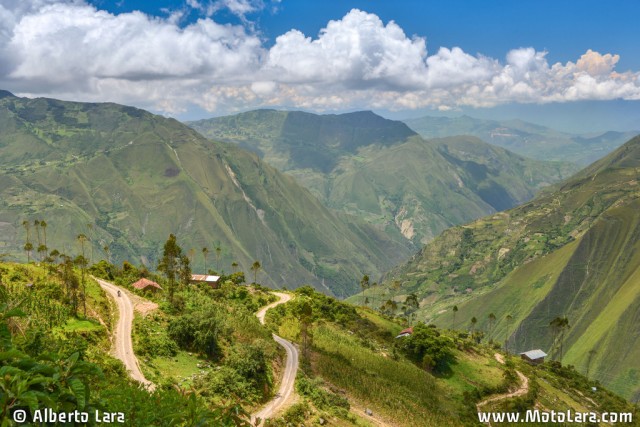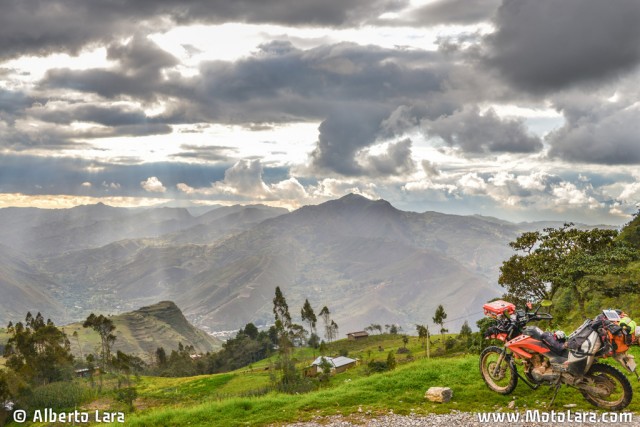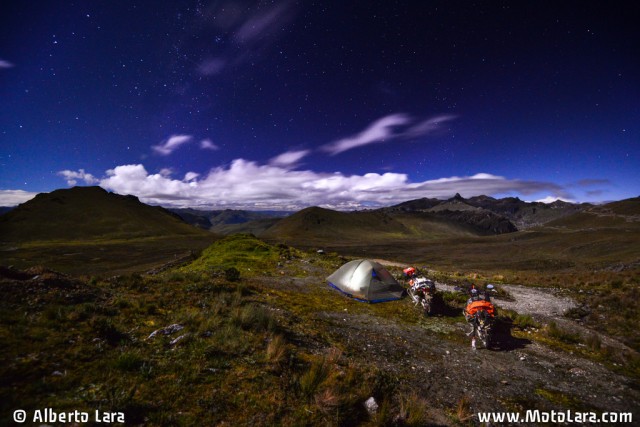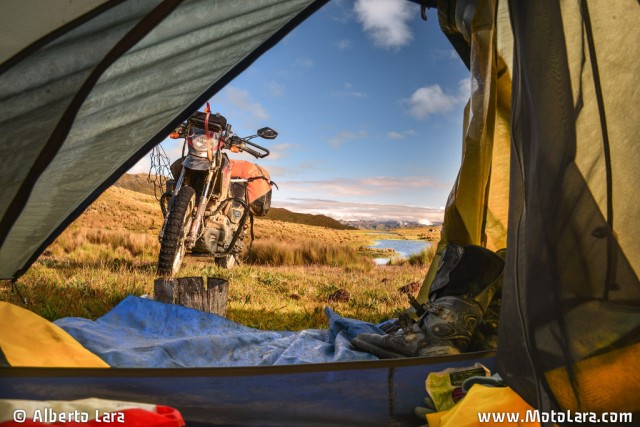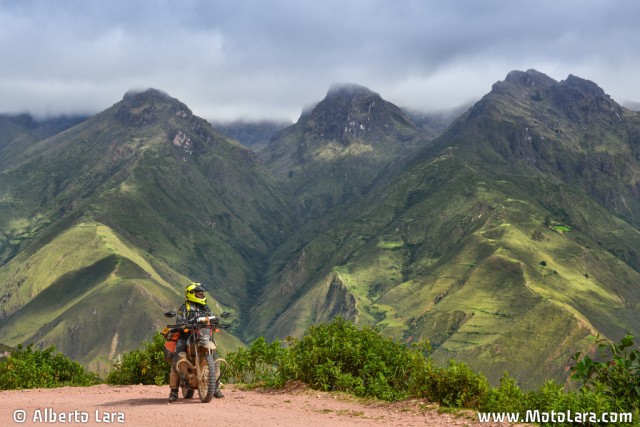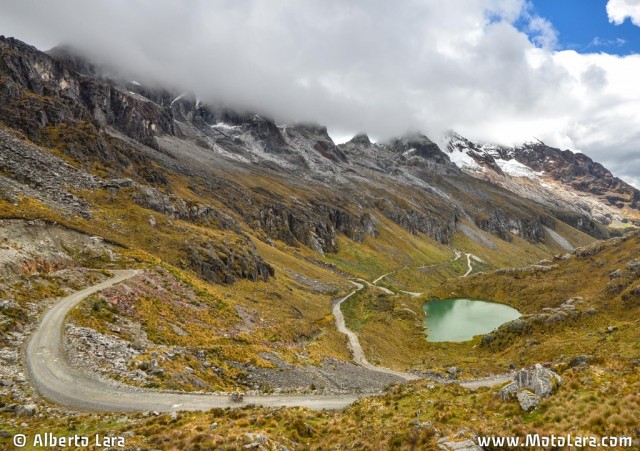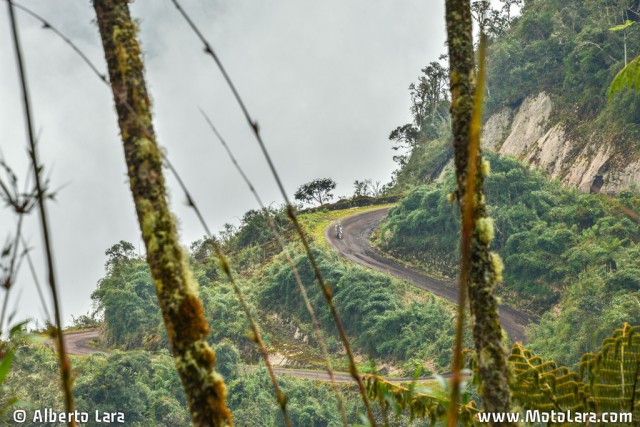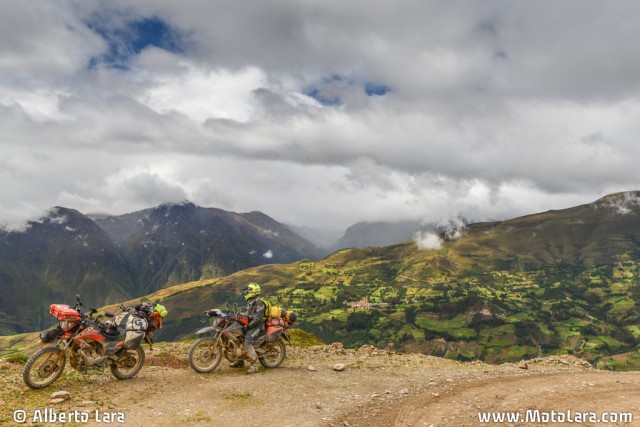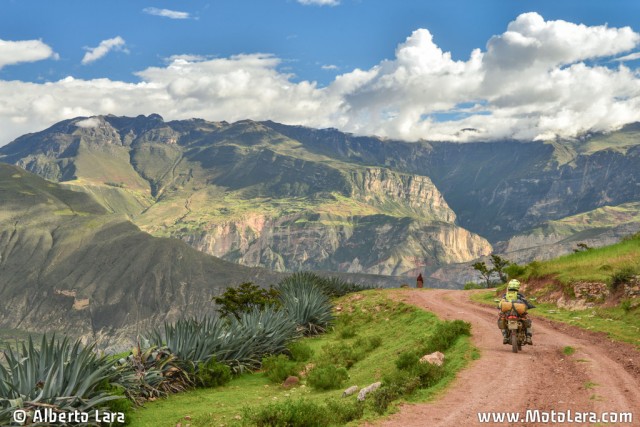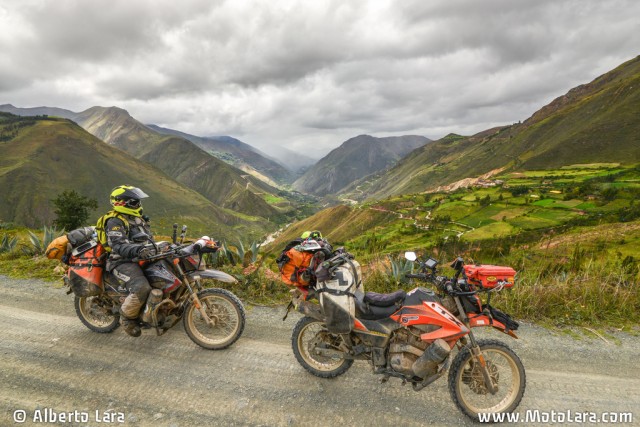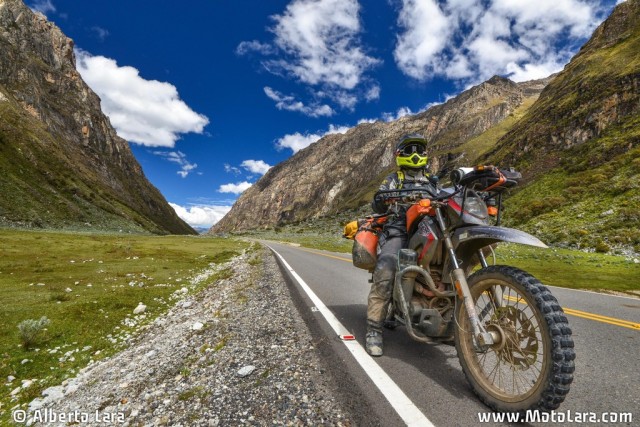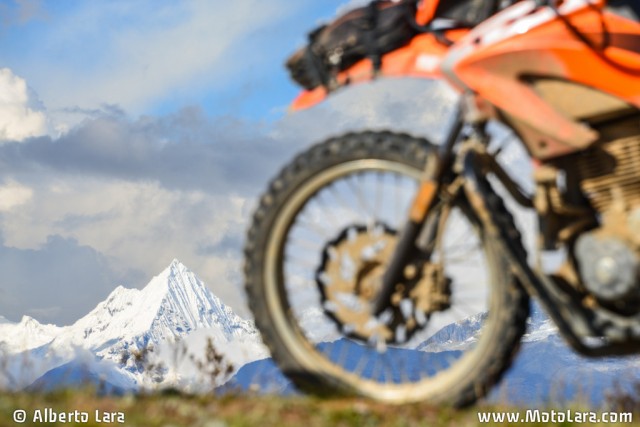Peru is a country rich in culture. It is also vast, challenging, and home to the best adventure riding to be found in both quality and in quantity. A great motorcycling road means different things to different people, but with terrain ranging from sandy desert, to mountain switchbacks, to lush jungle, Peru has something for everyone. With our two 200cc Keeway motorcycles we left the coastal surf town of Huanchaco on a five week trip heading for the mountains with altitudes reaching beyond 15,000ft. We didn’t really know where we were going, but we had our camping gear so it didn’t matter. We were freed from the shackles of hotel finding and itineraries, geared up with everything we’d need, and ready to follow every passing whim. If you like that sort of thing, it’s extremely liberating,
The Peruvian Northern Sierras (mountainous region of northern Peru) can be quite diverse. Do you want to ride among green giants showing off so many different shades of green you’d think it was a cartoon? What about endless switchbacks up the side of a mountain you were sure was too steep to climb by road? Maybe you would prefer the popular National Park of Huascaran in the Cordillera Blanca, where blue lakes and white peaks are served up 360 degree views. The good news is you don’t have to choose, because with as little as two weeks at your disposal you can see it all in northern Peru.
After leaving the hectic pace of the Panamerican Highway on the Peruvian coast, we had the roads to ourselves. The remoteness is part of the allure, and Peru has plenty of that to go around.
With a couple of back end slides I negotiated the first steep hills keeping my attention focused on the road and not the amazing desert scenery. The temperature felt like 100oF and we were both covered in a thick layer of dust which set like concrete thanks to loads of sweat. Riding gear can be your enemy sometimes, but since we’d both had a crash earlier in the morning we were thankful we were wearing it. The riding and weather were getting to us and just as luck would have it an oasis appeared at the side of the road. This oasis came complete with parrots singing songs, curiously swooping down on us, and a waterfall to refresh ourselves. How unexpected. The bad road somehow got worse from there, both steeper and rockier. It took everything we had to stay focused and keep going. We hadn’t seen another vehicle all day, we were both extremely tired from the challenging riding conditions, and it was only 11 o’clock in the morning. When we came up to the umpteenth river crossing of the day we both agreed it was time for a break. Thankfully the little stream provided a small but welcomed water source we both needed. While we only intended to take a break when we stopped, one thing led to another and we packed it in for the day, setting up camp and sitting in the small patch of shade. We didn’t care that it was only noon, we also didn’t care that it was the middle of nowhere and right beside the road. We were exhausted and didn’t want to ride any more that day. As dusk started to fall we went exploring further down the road, and to our surprise there was the Marañón river, providing us with a cool breeze. As we relaxed in our tent attempting to win the battle with the heat, we listened to the sounds of a pair of owls that were intently watching us from the top of the ridge.
Some will say that carrying around camping gear takes up valuable luggage space and adds extra weight to your bike, an unnecessary commitment when cheap hotels are easily found. I argue that camping isn’t just about cost savings, it’s about freedom and a more immersive travel experience. Enjoying camping is a prerequisite at this point, so gear yourself up accordingly by looking at this site: https://www.survival-cooking.com/flashlights/best-tactical-flashlight-for-the-money/. Get some mileage out of your camping set-up before embarking on a long multi-night trip so that you are comfortable with your system. Don’t focus too much on being a minimalist, instead be conscious of the special items that help you enjoy your camping experience, whether that is a Bluetooth speaker to listen to music after a long day or a chair to sit and enjoy the scenery. These things aren’t frivolous if they make the difference between a bearable camping experience and a great camping experience.
We had camped just 40 feet from the road the previous night and didn’t hear a single vehicle pass while we slept. There is something special about having a road all to yourself. Camping provides unique opportunities and with a bit of luck the views you are rewarded with when light breaks are unforgettable. Watching the sun in the morning advance through the valley, kissing the slopes of the steep mountains and bringing sunshine to our tent, is one of the many gifts of camping. To better better be prepared against insects and spiders you may run in to the way, visit campingfunzone.com for their vast information about camping, insects and animals.
Sometimes the beauty of camping lies not with the wild and remote setting, but meeting locals and getting a sense for the place you are travelling. Close to the town of Tacabamba, after a spirited conversation with two local ladies in which the honour of our riding skills had been challenged, we scored a camping spot on some quiet farmland. “If you can’t make it to the tower, then you are not a good rider” said the ladies, complete with wellies on their feet. Challenge accepted! The only catch was the muddy goat path leading to the farmers field, clearly a popular foot and donkey path judging by the prints. It was tricky in sections, but the Keeways performed flawlessly. Nothing like a local bike making quick work of local terrain.
It was a mad dash, or at least it felt like it, as both of us tucked in an aerodynamic position with our throttles pinned climbing the switchbacks south of the town of Parcoy. We were definitely the odd ones out with our small underpowered motorcycles, but surprisingly the truck drivers were very respectful. We had no traffic issues. We passed by the entrances of several mining properties hoping that the higher we got the less activity we would see, and a camping opportunity would present itself. Not only is the mining land private property, but there is a fair amount of pollution, not really ideal camping environments. As the road climbed the scenery opened up. The vividly blue sky complemented the landscape and the sun’s rays helped showcase the mountain peaks. We could see that we were approaching the summit and hoped that we would be able to get our bearings from the top. The scenery as we ascended the mountain pass was a sight to behold, and travelling at such a slow pace we had plenty of time to take it all in. Slow and steady sees the views.
We eventually reached the top of the pass and thankfully traffic was minimal, the trucks were all turning into the mines leaving us the road all to ourselves. After stopping to help two locals on a bike inflate their tires we picked up some local knowledge. In Peru temperature is governed by altitude so you should prepare for a chilly night if the Garmin reads more than 10,000ft of elevation. Our Garmin was reading 13,888 ft on that particular night so we unpacked the gloves and wooly hats. Warm food is also a lifesaver in these circumstances, so make sure you have supplies to make a warm beverage and a hot meal. We had our camp set up just before sunset so we were able to sit and enjoy the setting sun sweep across the barren mountain tops. As cold started to settle in we retreated to our tent for a hot meal and warm beverage, of course tucked into our down sleeping bags.
Despite the inconvenience of waking up cold, with my teeth chattering as I made breakfast, if you play your cards right the day soon warms up. Peru riding is a series of ups and downs, you can easily cover 8,000ft of elevation change within a day’s ride. This is Peruvian riding at its most pure, dramatic views and elevation change is guaranteed. Checking the topographic lines on your map is a good indication of what’s to come, and big changes are usually an indication of interesting roads ahead. We rode down through the valley to Huaylillas, gaining 60oF within a few hours and soon the cold camping became nothing but distant memories. There wasn’t much happening in the town and we drove down the empty main street. We stopped at a little store where we picked up some fruit and water. As we sat there having a snack and re-hydrating a little boy wearing a Messi football jersey came in to buy some things. He just started at us and our bikes with wide eyes, and I don’t blame him, in that heat we must have looked like firemen all dressed up head to toe. From camping up high in the pampas grass to buying fresh mangos at a corner store, this country has many different qualities.
We had a plan to get into the National Park of Huascarán, through the non-typical route, despite the map indicating we’d be on some lesser used roads. We only had one chance at this, otherwise there would be considerable backtracking to be done( 2+ days). As we approached the Marañón river, near the town of Urpay, the landscape was dominated by aloe plants and dry slopes with short grass. Aloe is one of my favourite local plants, and it is surprising how large some of the plants are just growing at the side of the road. As we approached the river it was clear from the remains scattered on both river banks that the bridge had failed. There was a small foot suspension bridge but it looked to be worse for wear missing several wooden slats and we were told later that it was out of commision as well. The only way across now was a cable cage, and the fella operating the cage didn’t normally service bikes as ‘large’ as ours, but that doesn’t stop Peruvian ingenuity. He found a helper, a local fisherman, and together with Alberto found a way to muscle the bike into the cage, well half of it stuffed in there anyway, and tied it down somewhat securely. The ropes they used looked like their good days were behind them but at times like these focusing the positives was necessary. I watched helpless as my bike with all my possessions flew across the river, at a fair clip, in the small metal cage made of rebar and wood planks.
At the other side of the river the two young men struggled to get my bike off the cage. The unloading area had a gap of 3 ft between the cage and a 40 ft vertical drop-off to the river below, not usually a problem when unloading people, bicycles or very small motos. Even at 200cc our motos were bigger than most bikes in Peru. It was a nerve-wracking experience watching from across the river, we even discussed ‘plan B’ in case we lost a bike in the river but as things do everything turned out fine in the end.
Loosely basing ourselves out of Huaraz in the Ancash region, we were set up perfectly to explore the white mountain peaks and gorgeous scenery of the Cordillera Blanca. We don’t recommend casually rolling into town during Semana Santa (Easter week), which is what we did, as it will be difficult and expensive to find a hotel room, however this is a great place to start. We found it easy to find places to camp within the national park and in Llanganuco there is official camping, the only campground we encountered during the 5 weeks, although the bathroom facilities were in dire straits. Llanganuco is well know for the beautiful twin lakes that greet you as you enter the park from the main entrance, but the narrow switchback road that leads across the mountains to Yanama is well worth a look. At the summit, Paso Portachuelo, we stopped to make some tea and grab a snack. While we relaxed the mountain peaks of Huascarán and Huandoy shyly peaked out from the clouds from time to time. The air is thin and the wind is cold, but the stillness of watching the mighty mountains interact with their environment is worth a little bit of discomfort.
Exploring the mountain road to Chacas through the park we inquired at the park gate if there was any camping. The guard didn’t seem to have a problem with us camping ‘anywhere’ as he put it but feared for our safety, however we never had any issues. The road is perfectly paved and a dream to ride if you are into switchbacks covering over 3,000ft in under 20min. The weather was rainy and foggy but with patience comes great reward. We camped at the summit of 15,750 ft, tucked away from view and waited out the weather. The blue sky did eventually come and we were rewarded with glacier and mountain views.
Eventually all good things must come to an end. The return to the coast was a series of narrow paved switchbacks that criss-cross their way from 14,200ft to sea level with staggering views and virtually no traffic to spoil the fun. The landscape slowly changes from lush green plants, trees with beautiful fragrant flowers and fruit, to orange dry desert mountainside slopes. We were in biking heaven on these forgotten roads, our Keeways feeling relatively sporty. Once we reached the staggeringly boring Panamerican highway the fun was over as we had to compete with the large trucks and traffic on one of the world’s longest highways with the world’s most aggressive drivers!
Camping can compliment your riding trips, giving you access to locations you never thought possible. Carrying camping gear removes the stress of having to make it to a particular destination and lets you focus on the riding and the journey. Aren’t we all out there just trying to enjoy the journey?
Insider Tips for Bike Travel in Peru
- Buy fresh food from the market and eat in the Plaza de Armas. This was our typical routine for lunch. Parking up in the Plaza attracts attention from locals and we were able to meet more people this way.
- Learn basic Spanish either by buying a travel phrase book or downloading an app to your phone. Do what you can with the language and meet local people. It will enrich the experience tenfold! Plus they love bikes!
- To find a quiet camping spot try to get off the main road, looking for a secondary road. From there you should be able to find a way to get off this secondary road into the bush and a camping spot will present itself.
- Explore beyond the typical tourist destinations of Nazca and Machu Picchu. There are endless historic sites to see without the crowds all over the country and plenty of natural beauty.
Read more from Naomi and Alberto at: www.motolara.com
Visit their FaceBook page at: motolara
About the authors:
Naomi
Naomi Tweddle was born in Victoria, Canada and grew up in a small island community in the Southern Gulf Islands. She still calls Canada home; currently living in the beautiful province of British Columbia. From an early age Naomi was exposed to motorcycles as her parents took her and her sister on bike trips aboard their ‘78 Triumph Boneville and ‘73 Honda CB. She started riding motorcycles at the age of 16. When motorcycle adventure travel became a thing Naomi was naturally drawn to the idea and became a passion of hers. Naomi has documented her travels spanning over 100,000km and 12 countries through blogging and photography and continues to pursue travel opportunities riding motorcycles. She has curiosity for the unknown, for the challenge and to see new places, whether it’s 100km from home or 25,000km from home. There is something new lurking around every corner.
Alberto
Born and raised in Peru, Alberto grew up in the perfect environment to become a tireless traveler. Alberto’s dad worked in remote areas in the Peruvian Andes due his profession in the mining industry, which required the family to regularly travel deep into the mountains. Exposed to the beauty and magic of Peru’s mountain regions, Alberto’s appreciation for these areas developed from an early age. Alberto’s dad had his first motorcycle (Honda C50) when he was a teenager and when Alberto turned 12, his dad bought him a 50cc scooter which he rode until he was 17. Alberto came to Canada at the age of 23 searching for new experiences and challenges. Five years later, he met Naomi, his partner in life. Alberto was re-introduced to the world of two wheels by Naomi, who not only influenced Alberto’s decision to get a motorcycle but also taught him how to operate a proper motorbike. Photography was one of the hobbies Alberto developed while in Canada. Combining his passion for traveling, the incomparable thrill he gets from riding motorcycles and his sharp eye for photography was a spontaneous occurrence.



